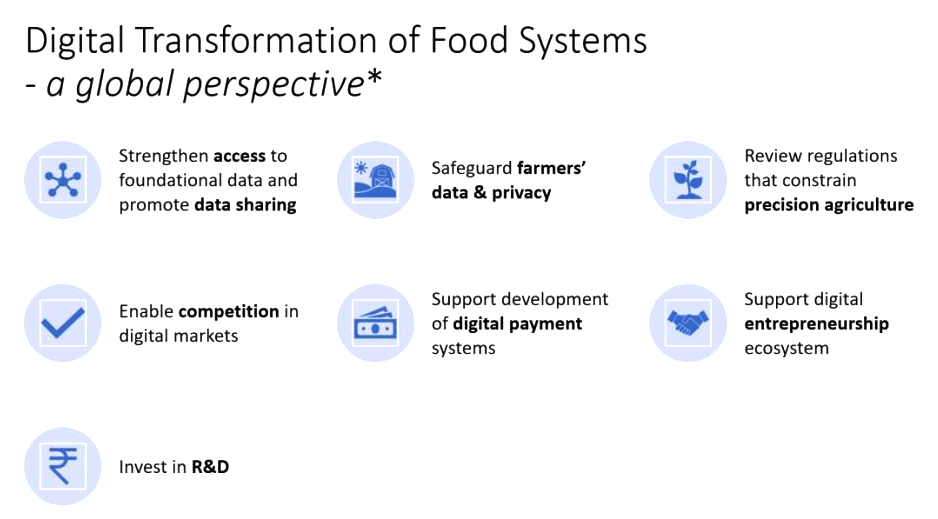Agriculture
Digital Revolution in Indian Agriculture
- 09 Oct 2021
- 7 min read
This editorial is based on the article Seeding a data revolution in Indian agriculture which was published in The Hindu on 08/10/2021. It discusses the need for digital technologies for the agriculture sector and suggests a way forward.
Digital technologies are transforming all the sectors of the economy and the society in innumerable ways. Communications, banking, payments, travel, energy, healthcare, taxation, and governance have significantly benefited by deploying digital solutions. Agriculture and allied sectors call for the need of digital disruption in order to convert challenges of agriculture into opportunities.
Recently, a consultation paper on the India Digital Ecosystem of Agriculture (IDEA) from the Ministry of Agriculture and Farmers’ Welfare (MoA&FW) was released. It talks about a digital revolution in the agriculture sector. The fact is that every segment of present-day life is data-hungry.
Concept of IDEA
- The farmer and the improvement of farmers’ livelihood is the aim of the IDEA concept and it is proposed to happen through tight integration of agri-tech innovation and the agriculture industry ecosystem to farming and food systems.
- The IDEA principles explicitly talk about openness of data, which means open to businesses and farmers, indicating the integration.
- Value-added innovative services by agri-tech industries and start-ups are an integral part of the IDEA architecture.
Objective of IDEA
- To enable the farmer to realize higher income and better profitability through access to right information at the right time, and from innovative services.
- To enable better planning and execution of policies, programs, and schemes of the Central and State governments, and also of the private sector and Farmers Producer Organizations (FPOs).
- To enhance efficiencies in the usage of resources including land, water, seeds, fertilizers, pesticides, and farm mechanization by providing easier access to information.
- To build capacities across the gamut of digital agriculture and precision agriculture
- To give a fillip to R&D and Innovations in agriculture through access to high-quality data.
- To adopt the best principles of cooperative federalism while working with the states and union territories for the realization of the vision of IDEA.
- To formulate and leverage PPP frameworks for realizing the ‘power of the digital’.
Issues of Adoption of Technologies
- Potential of Data Misuse: The IT industry has opposition to IDEA mainly due to the ethics of creating a Unique Farmer ID based on one’s Aadhaar number and also the potential for data misuse.
- Digital Disruption is a Double-Edged Sword: The digital ecosystem relies on digital disruption to improve farmers’ livelihoods. However before bringing such disruptions it must be studied how much farmers would be prepared to benefit from these newly emerging business environments.
- In this context, the Union government has emphasised the significance of the farmer’s database being prepared and has sought the support of States.
- Lack of Awareness: A majority of small and marginal farmers are not technology-savvy. That most of them are under-educated for capacity building is ignored amidst these ambitious developments.
- However, more investments into the agriculture sector can benefit farmers and how the technology fix will help resolve all the issues of Indian agriculture is unclear in the IDEA concept.
- Reaction of the Farmers Against Reforms: The farmers do not always take reforms in a positive way. In this regard, the government will need to take farmers and their organisation in confidence.
Way Forward
While agreeing on the fact that a data revolution is inevitable in the agriculture sector, given its socio-political complexities, we cannot just count on technology fixes and agri-business investments for improving farmers’ livelihoods.
- Capacity Building of the Farmers: There need to be immense efforts to improve the capacities of the farmers in India – at least until the educated young farmers replace the existing under-educated small and medium farmers.
- This capacity building can be done through a mixed approach – preferably building the capacities of individual farmers or coping with the new situation by establishing support systems, through FPOs and other farmers associations where technical support is available for farmers.
- Considering the size of the agriculture sector of the country this is not going to be an easy task but would need a separate programme across the country with considerable investment.
- Adopting Recommendations of World Bank Report:
- ‘The digital revolution—and the data it generates—are key to building an agriculture and food system that is efficient, environmentally sustainable, equitable, and able to link the world’s 570 million farms with 8 billion consumers’.
- The Bank has suggested 7 strategies (as in infographic below) to achieve the much desired digital transformation.
Conclusion
Adoption of a holistic ecosystem approach to address the multiple challenges faced by the agriculture sector is of national importance, to fulfil the aspirations like Doubling Farmer’s Income and achieving the SDG’s. A multi-stakeholder approach is essential with the government playing the role of an enabler of the ecosystem players.
|
Drishti Mains Question Digital technologies are transforming all the sectors of the economy and the society in innumerable ways. Discuss how it can bring transformation in the current state of the Indian agriculture system. |





